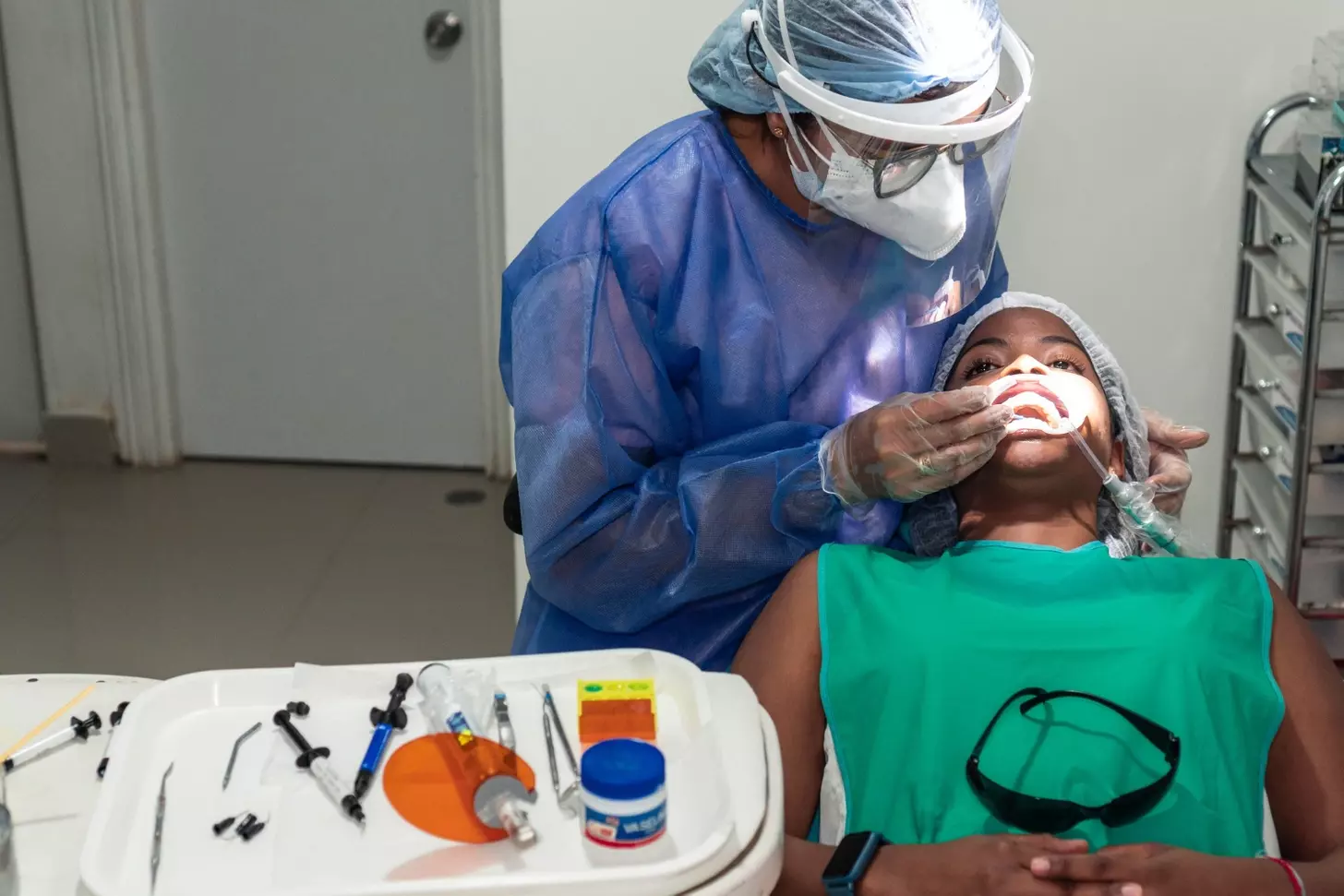
Getting a dental bone graft can seem scary. At Liv Hospital, we make sure you’re comfortable and know what’s happening. A dental bone graft is a surgery that adds bone to your jaw. It’s often needed before getting a dental implant.
The surgery can be done with local anesthesia, sedation, or general anesthesia. This choice depends on how complex the surgery is and how nervous you are. We know it’s important to know what to expect.

Dental bone grafting is key to rebuilding the jawbone. It’s needed when gum disease or trauma damages it. This surgery replaces missing or damaged bone, making it ready for dental implants.
A dental bone graft transplants bone tissue to fix or grow the jawbone. It’s often needed when a tooth is lost and the bone around it weakens. The graft material helps new bone grow, blending with the existing bone over time.
Several reasons might lead to needing a bone graft:
Knowing these reasons helps patients see why bone grafting is important in their treatment.
Different materials are used in dental bone grafting:
Each material has its benefits and is chosen based on the patient’s needs and the surgeon’s advice.
The time it takes for a dental implant can be placed varies. It usually ranges from three to six months, depending on how well the bone graft integrates.

Wondering if you’ll be asleep for a dental bone graft is a big question. The answer depends on a few things. Patients often worry about the anesthesia used for these procedures.
Thinking about a surgical procedure can be scary. Knowing about your anesthesia choices can help ease your worries. The anesthesia for a dental bone graft can change based on the procedure’s size, your health, and how you feel about dental work.
For many dental bone grafts, local anesthesia is the top choice. It numbs the area where the graft will happen, so you won’t feel pain. This anesthesia is given through an injection and works well for most bone grafts.
If you get nervous or uncomfortable during dental visits, sedation dentistry might be for you. Sedation can be light or deep, depending on what you need. Light sedation helps you relax but stay awake. Deeper sedation is used for more complex cases or when you’re very anxious.
In some cases, general anesthesia is needed for a dental bone graft. This makes you completely asleep during the procedure. General anesthesia is usually for more complex grafts, severe dental anxiety, or long procedures.
Several things decide what anesthesia you’ll get for your dental bone graft, including:
To understand how these factors affect your choice, let’s look at a comparison of anesthesia options:
| Anesthesia Type | Typical Use | Patient Experience |
|---|---|---|
| Local Anesthesia | Straightforward bone grafts | Numbness in the graft area, fully awake |
| Sedation Dentistry | Anxious patients or complex procedures | Relaxed, may be awake or semi-conscious |
| General Anesthesia | Complex or lengthy procedures, high anxiety | Completely unconscious |
By knowing your options and talking to your dentist, you can choose the right anesthesia for you.
Getting a dental bone graft involves several steps. Knowing these can help make the process smoother. From getting ready before the procedure to caring for yourself after, each step is important.
Before the bone graft, you’ll get specific instructions. You might need to change your diet or take different medications. It’s key to follow these steps to avoid any problems.
The surgeon will carefully place the bone graft during the procedure. This needs to be done with great care to ensure the graft heals well. Modern technology helps make this part as easy as possible.
The time it takes for a bone graft surgery varies. It depends on the type of graft, where it’s placed, and your body. Usually, it can take from 30 minutes to several hours.
| Procedure Type | Typical Duration | Complexity Level |
|---|---|---|
| Simple Bone Graft | 30 minutes – 1 hour | Low |
| Complex Bone Graft | 1 – 2 hours | Moderate |
| Advanced Bone Graft with Sinus Lift | 2 – 3 hours | High |
After the surgery, you’ll get advice on how to care for yourself. This includes managing pain, swelling, and bleeding. It’s normal to feel some discomfort and swelling. Eating soft foods and avoiding hard activities is recommended.
Knowing what to expect from a dental bone graft helps prepare you. Our team is here to support you every step of the way.
Knowing what to expect after a tooth extraction and bone graft is key for a smooth recovery. You might feel some pain, swelling, and bleeding at first. These symptoms usually go away in a few days.
The first 24-48 hours are very important. Resting and keeping your head up can help with swelling. Eating soft foods and avoiding hard work are also important.
Swelling and bleeding are common after a tooth extraction and bone graft. To handle these, try:
After a tooth extraction and bone graft, eat soft foods for a few days. Good options include:
Stay away from hot, spicy, or hard foods that can bother the surgical area.
It’s best to limit your activities for a few days after the procedure. This means:
By following these tips and knowing what to expect, you can make your recovery easier and more successful.
Knowing your pain management options is key to a smooth recovery after a dental bone graft. Good pain management helps you heal well and get back to your daily life quickly.
Most people feel mild to moderate pain after a dental bone graft. As one source says, “after implant surgery, most people describe the discomfort as mild soreness, which can be managed with over-the-counter or prescribed medication.” Pain levels can differ based on your pain tolerance and the procedure’s complexity.
Dentists often give pain medications after a dental bone graft. These meds help control discomfort. It’s important to follow your dentist’s advice on dosage and how often to take it for safe and effective pain relief.
Most discomfort can be managed with prescribed medication. But, knowing the side effects and telling your dentist about any issues is key.
For mild pain, over-the-counter (OTC) pain relievers can work well. Ibuprofen and acetaminophen are common ones. They help reduce pain and swelling, making recovery easier.
“The use of over-the-counter pain relievers can be an effective way to manage mild pain following a dental bone graft.”
There are non-medication ways to manage pain too. Using cold compresses can help with swelling. Relaxation techniques like deep breathing or meditation can also help. Eating soft foods avoids putting pressure on the graft site.
Using these methods together can help manage pain and make recovery smoother. Pain management is a mix of medical and non-medical strategies.
Knowing how long it takes to heal after a bone graft is key for those waiting for dental implants. The healing process has several stages. Each stage is important for the graft to integrate well and for the implant to be placed successfully.
The first healing phase lasts about 1-2 weeks. In this time, your body starts to heal the grafted area. It’s very important to follow the care instructions after the procedure to heal right and avoid problems. Keep your mouth clean and avoid hard activities.
After the first healing phase, the next stage starts and can last several months. The grafted bone starts to join with the existing bone, making your jaw stronger. This stage is key for a strong base for the dental implant.
It usually takes 3-6 months for the bone graft to fully integrate. This time lets the grafted bone fully mix with the native bone, making a solid base for the dental implant. How long it takes can depend on many factors.
Many things can change how long it takes to heal after a bone graft. These include your health, the bone quality, and following care instructions. Smoking and some health issues can slow healing, but good mouth care and a healthy diet help.
We know waiting can be hard for patients. But it’s very important to wait long enough for healing to ensure the dental implant works well for a long time. Our team will watch your progress and give you personal advice during the healing time.
Knowing about the different bone grafts and their pain levels helps patients get ready for recovery. Bone grafting is used in many dental surgeries, like dental implants.
Socket preservation grafts keep the bone in the socket after tooth extraction. This graft is less invasive and causes little pain. Patients might feel some discomfort, but it’s usually mild and can be eased with over-the-counter pain meds.
Block bone grafts move a bone block to the jaw to add to the bone. This is more invasive and can cause more pain. Patients might need stronger pain meds to manage the pain during recovery.
A sinus lift adds bone to the upper jaw. The pain from this procedure can vary. Most patients feel moderate pain that goes away in a few days with the right pain care.
Bone grafts from the hip are more invasive and can hurt more. The pain comes from both the dental work and the bone harvest. Patients might feel a lot of pain in the hip, which can be eased with prescribed meds. This pain usually goes away in a few weeks.
To understand the pain levels of different bone grafts, let’s look at a comparison:
| Type of Bone Graft | Typical Pain Level | Recovery Time |
|---|---|---|
| Socket Preservation | Mild | 1-3 days |
| Block Bone Graft | Moderate to Severe | 1-2 weeks |
| Sinus Lift | Moderate | 3-7 days |
| Bone Graft from Hip | Significant | 2-4 weeks |
The table shows that pain and recovery times differ a lot among bone grafts. Knowing these differences helps patients prepare for their procedure and manage their pain expectations.
The idea of doing bone graft and implant placement in one day is getting more attention. But, it’s not for everyone. It can save time and might be less painful for some. Yet, it’s important to know who can have this done.
Not everyone can have bone graft and implant done at the same time. It depends on several things. These include the patient’s health, the bone quality, and what the implant needs.
To qualify for same-day procedures, patients usually need:
Doing bone graft and implant at the same time has some good points. It can make treatment shorter, might be less painful, and you won’t need as many visits. But, there are also downsides. The procedure could be more complicated, there’s a chance for problems, and it needs careful planning.
| Benefits | Risks |
|---|---|
| Shorter treatment time | More complex procedure |
| Potentially less pain | Higher chance of complications |
| Fewer visits | Needs precise planning |
Managing pain for same-day bone graft and implant is key. We use local anesthesia and sedation to keep patients comfortable during the surgery. Afterward, we might give pain meds and use other ways to help with pain.
Good pain management includes:
It’s important to know about the possible problems and side effects of dental bone grafts. This knowledge helps prepare patients and improves their experience. We aim for the best results, but knowing these details can help manage expectations.
Patients might feel swelling, bleeding, and discomfort after a dental bone graft. These symptoms are usually short-term and can be managed with proper care.
We suggest eating soft foods and avoiding hard activities to lessen these effects. Sometimes, we give pain meds and antibiotics to prevent infection.
Watch the graft site for signs of infection like more redness, swelling, or fever. If you notice these, call us right away.
We can treat infections with antibiotics. But catching them early is key to avoiding bigger problems. Keeping your mouth clean also helps prevent infections.
Graft rejection is a rare but possible issue with dental bone grafts. Symptoms include ongoing pain, swelling, or feeling like the graft is loose. If you notice these, we need to check it out fast.
If there’s graft rejection, we might have to remove the graft. But this is rare. With good care and watching, the risk is low.
If you have unusual symptoms after a dental bone graft, like severe pain, too much bleeding, or infection signs, call us. We’re here to help and guide you through your recovery.
Knowing about possible problems and side effects helps you take care of yourself better. This way, you can get the best results from your dental bone graft.
After your dental bone graft, following the right recovery tips can make all the difference. A successful recovery is key for healing and the graft’s long-term success.
Good oral hygiene is vital after a bone graft to avoid infection and aid healing. We suggest gentle brushing and rinsing with salt water or antibacterial mouthwash as your dentist advises. Proper oral care can significantly reduce the risk of complications.
Eating a balanced diet rich in vitamins and minerals is important for healing. Foods high in calcium, vitamin D, and protein are beneficial. Including these nutrients in your diet can enhance your body’s ability to heal.
| Nutrient | Benefit | Food Sources |
|---|---|---|
| Calcium | Essential for bone health | Dairy products, leafy greens |
| Vitamin D | Aids in calcium absorption | Sunlight, fatty fish, fortified dairy |
| Protein | Supports tissue repair | Meat, fish, eggs, legumes |
Regular dentist visits are needed to check on your healing. These visits help catch any issues early. It’s important to stick to your dentist’s follow-up schedule.
Knowing how to care for your graft long-term is key for its success. This includes good oral hygiene and regular dental check-ups. Long-term care can significantly impact the durability and success of your bone graft.
“Proper aftercare and follow-up are key to a successful bone graft outcome.”
” Dental Care Professional
By following these tips, you can ensure a successful recovery and enjoy the long-term benefits of your dental bone graft.
Understanding the dental bone graft procedure and recovery is key for those considering it. This treatment is significant and needs careful thought. We summarize the main points to help patients prepare for success.
The time it takes for gums and bone to heal varies. Gums usually heal in 3-4 weeks, but bone and full recovery can take months. Managing pain is important, and over-the-counter painkillers like ibuprofen or acetaminophen work well.
We at our institution aim to offer top-notch healthcare and support for international patients. With the right care and expectations, dental implant surgery can lead to a smooth recovery. We aim to provide the best care at every step, ensuring our patients have a successful outcome.
The anesthesia for a dental bone graft depends on the procedure’s extent and your anxiety level. You might get local anesthesia, sedation dentistry, or general anesthesia.
A dental bone graft is a surgery to transplant bone tissue. It’s needed to repair or rebuild jaw bone. This is often necessary before getting a dental implant due to tooth loss, gum disease, or trauma.
After a tooth extraction and bone graft, you’ll feel some discomfort, swelling, and bleeding. The first 24-48 hours are key to managing these symptoms well.
The healing time after a bone graft varies. The initial healing phase is 1-2 weeks. Complete integration usually takes 3-6 months.
Bone grafts from the hip are more invasive. They can cause higher levels of pain after surgery compared to other grafts.
Pain levels vary, but most people feel mild to moderate discomfort after a dental bone graft. There are effective pain management options available.
For some, it’s possible to get a bone graft and dental implant on the same day. This can save time, but it’s not for everyone.
Common side effects include swelling, bleeding, and discomfort. Watch for signs of infection like increased redness, swelling, or fever.
Keep your oral hygiene good, follow dietary restrictions, and go to follow-up appointments. This is key for a successful recovery and proper graft healing.
Bone graft materials vary. They can be autografts (from your own body), allografts (from a donor), xenografts (from an animal), or synthetic materials.
Surgery time varies based on the case’s complexity. It can last from 30 minutes to several hours.
Healing involves an initial phase, intermediate healing, and complete integration. This can take several months.
Yes, you can manage pain without medication. Try relaxation, cold therapy, and over-the-counter pain relief options.
Subscribe to our e-newsletter to stay informed about the latest innovations in the world of health and exclusive offers!
WhatsApp us